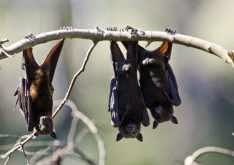Bats may hold henipavirus threat for W Africa: study

|
Getting your Trinity Audio player ready...
|
 According to a report by AFP, A family of lethal viruses that has
According to a report by AFP, A family of lethal viruses that has
leapt from bats to humans in Australia and Asia may also pose a threat
in West Africa, where bats are butchered for meat, scientists reported
Tuesday.
Known as henipavirus, the family has two main members, Hendra and
Nipah, which came to notoriety in the 1990s.
They have been blamed for rare but worrying outbreaks of encephalitis
and respiratory illness among domestic animals and humans in remote
Australia, south and southeast Asia.
Like Ebola, henipavirus has a natural reservoir in fruit bats, which
are immune to the virus but can pass it on to humans who come into
contact with their blood, saliva or droppings.
In some henipavirus episodes, mortality rates have been greater than 90 percent.
Reporting in the journal Nature Communications, scientists said they
suspect henipavirus may be making a similar bats-to-humans jump in
west Africa.
The evidence, based on field work in Cameroon, is only preliminary but
should serve as a warning, they said.
"Our study found the first evidence — written in the immune cells of
people living in our African study area — that humans have been
exposed to henipaviruses," said Benhur Lee, a microbiologist at the
Icahn School of Medicine at Mount Sinai, New York.
The work entailed scanning blood samples from 44 fruit bats and 497
people living in 13 rural locations across southern Cameroon.
The goal was to look for antibodies — first-line defenders made by
the immune system in response to a microbial intruder — that were
specific to the henipavirus family or a close relative.
If so, this would show that the bat or the person had at some point
been infected by henipavirus or henipa-like virus.
It was not, though, an indicator of whether they had fallen sick, or
could fall sick, from it.
The team found that 48 percent of bat samples showed the telltale
response to infection.
Of the 497 human samples, 227 came from people who said they had
previous contact with bats, of whom three to four percent had antibody
traces in their blood.
Most of them had butchered bats for meat, or lived in deforested areas
in close proximity to bats.
– Cause of illness? –
The research was not designed to probe whether anyone had fallen ill
from the henipavirus in Cameroon.
The findings threw up two possibilities, the scientists said.
One is that this version of the virus may not be as deadly as those
found in past Asian-Australian outbreaks.
The other is that the virus may have been a hidden cause of
encephalitis in remote villages, or caused fevers that were
misdiagnosed as malaria, yellow fever or typhoid.
Further investigation is needed, but authorities should take note, Lee said.
"The tragedy of Ebola, which also jumped into humans from bats in
Africa, argues that we must heighten our surveillance of viruses on
the verge of spillover from animals into humans.
"HIV, SARS [severe acute respiratory syndrome] and West Nile virus
were also unknown until they emerged."
Ebola has killed more than 5,100 people and infected about 14,500
since it emerged in Guinea in December, according to the World Health
Organization (WHO).





